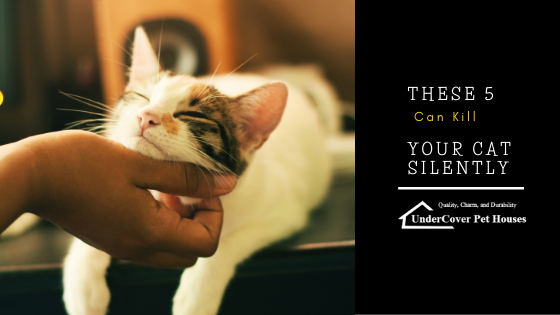 Loading... Please wait...
Loading... Please wait...Silent Killers: 5 Common Cat Diseases That Can Hide Unnoticed
Posted by Danny MacDonald on 2021 Jan 13th

Your adorable cat makes for a great companion, and for that reason, it's imperative to stay on top of your cats' health. When we think of our cat being sick, we often look for the common symptoms of sickness in cats. However, several silent cat-killing diseases with no apparent symptoms can progress to severity before they are discovered.
As a responsible cat guardian, you should also be aware of some of the common silent killers in cats. Having the knowledge of the most common silent killers are, you can understand what symptoms to look for and benefit from getting your cat prompt and lifesaving medical response.
Here are five cat-killing conditions that can hide undetected.
1) Kidney Disease
Chronic kidney disease is the most common silent killer in cats and can be hereditary. It's rarely evident until 75% of both of your cat's kidneys function is affected with symptoms including:
- Excessive drinking and urinating
- Larger clumps in the litter box
- Weight loss
- Decreased appetite
- Bad breath caused by toxins in the blood
- Lethargy
Chronic kidney disease doesn't have to be terminal. With the right management and treatment, your cat can go on to live a long life. Low protein diets, routine blood work, more water intake, and medications can help improve your cat's kidney function.
2) Diabetes
Diabetes causes your cat's pancreas to secrete a smaller amount of insulin than they need. So common is diabetes that it's estimated that 1 in 230 cats will develop diabetes during their lifetimes, and those statistics keep rising. Overweight to obese cats are at a greater risk of developing diabetes.
It's easy for diabetes symptoms to go undetected, but are all signs are to those of kidney disease and include;
- Frequent urination and drinking/thirst
- Fatigue
- Larger clumps in the litter box
- Weight gain/weight loss
- Decreased/ ravenous appetite
- Abnormal walking
Diabetes is a costly disease to treat since it often requires twice-a-day insulin injections. What's more, you need to make dietary changes to include more protein and fewer carbohydrates. With enough care and support, diabetes can be managed save for extreme complications like hyperglycemic syndrome, diabetic ketoacidosis, etc., which can be life-threatening.
3) Heart Disease
Heart disease is so deadly in cats because it shows few to no symptoms in its early stages, not to mention a cat’s tendency to hide illness. Many cats suffer from heart disease, with most not showing signs until the disease reaches an advanced stage. In advancement, heart disease can manifest in heart failure, dyspnea, coughing, thromboembolism (clots), cardiac arrest, or sudden death.
All cats are at risk of developing heart-related diseases. Notably, some breeds, including the Ragdoll (and related species), Maine Coon, Sphynx, and Rex breeds are at higher risk. Moreover, cats eating low quality foods that are taurine deficient are also at higher risk.
Talk to your vet immediately if you suspect that your cat has heart disease. Prompt diagnosis may improve prognosis and prolong your cat's life. Besides, if you own a breed known to be prone to cardiomyopathy, consult your vet.
4) Hyperthyroidism
Hyperthyroidism causes your cat's thyroid gland to produce excessive thyroid hormone. It's most common in middle-aged to senior cats and encompasses many of the same symptoms as kidney disease, including:
- Excessive drinking and urination
- Vomiting/diarrhea
- Weight loss
- Racing heart rate
- Hypertension — acute blood loss, neurologic signs, clots, or stroke
- Organ injuries like heart murmurs
Given the right treatment and medication, hyperthyroidism is treatable. The earlier it's identified and treated, the better the recovery chances and the less likely your cat develops side effects or organ damage.
5) Cancer
Unfortunately, as cats live longer, their likelihood of developing cancer increases. Typically, cancer produces no symptoms until it has spread throughout the body. At that point, the prognosis is low, but the disease is treatable. For this reason, it is essential to recognize the signs of cancer so you can have an early diagnosis and start treatment.
- Weight loss and loss of appetite
- Vomiting and diarrhea
- Difficulty in breathing
- Abdominal bloating
- Weakness or lethargy
- Hiding and restlessness
- Fever
The most common cancers in cats are skin and gastrointestinal cancer.
As most cat parents can relate, it's not always easy to identify when your kitty is sick. However, adopting a healthy lifestyle and scheduling routine vet checkups can go a long way in helping your cat prevent or catch these and many more silent killers before it's too late. With most of these diseases, the sooner they're detected, the sooner your vet can treat them.
